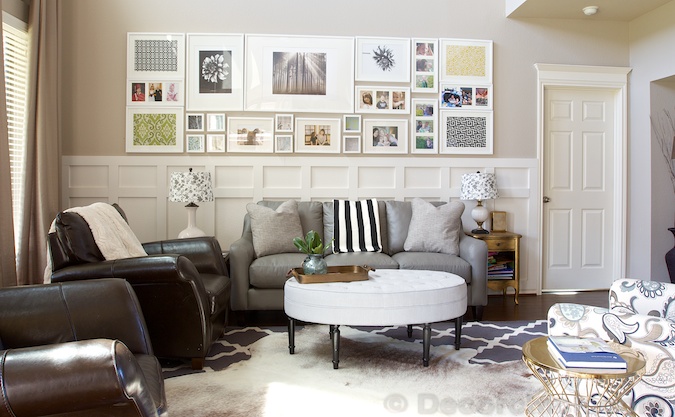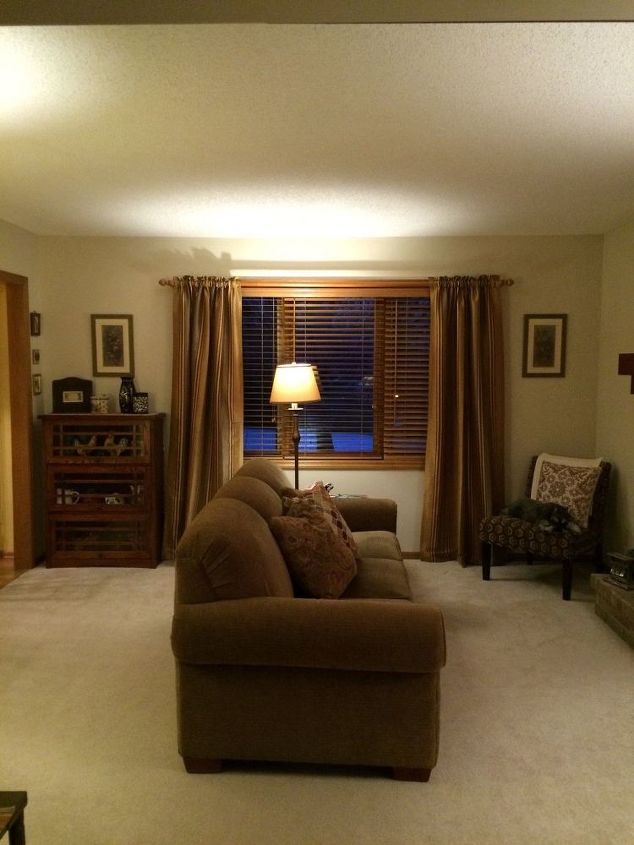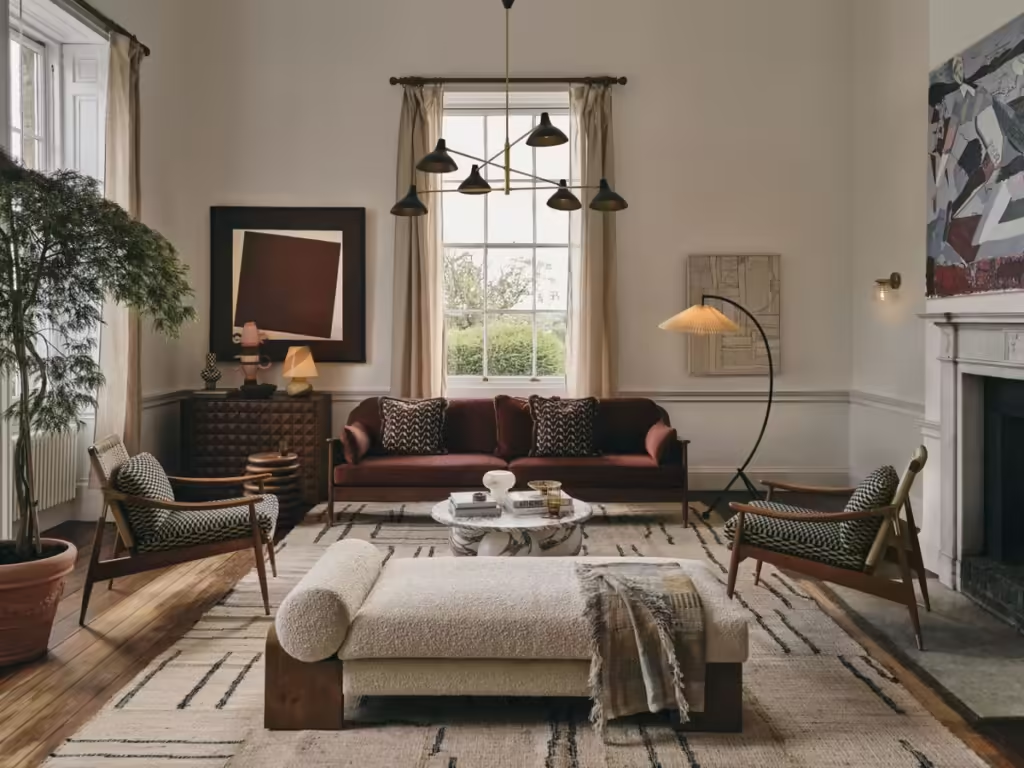How Many Lamps in Living Room, Two to four lamps provide balanced lighting in a living room. The exact number depends on room size and lighting needs.
Lighting plays a crucial role in creating a comfortable and inviting living room. Proper lighting enhances the ambiance, mood, and functionality of the space. It’s essential to have a mix of ambient, task, and accent lighting. Table lamps, floor lamps, and wall sconces can help achieve this balance.
Consider the room’s layout, natural light sources, and specific activities. Reading areas may need more focused light, while general areas benefit from softer illumination. Choosing the right lamps not only improves visibility but also adds to the room’s aesthetic appeal. Make sure to select lamps that complement your decor style and meet your lighting requirements.
Importance Of Proper Lighting
Proper lighting in the living room is essential. It sets the mood and ensures functionality. The right number of lamps can transform the space.
Impact On Mood
Lighting can influence how we feel. A well-lit room feels cozy and inviting. Bright lights can make us feel alert and energized. Dim lights create a calm and relaxed atmosphere. The right balance affects our mood positively.
Functional Needs
Different activities need different lighting. Reading needs a bright lamp. Watching TV needs softer lighting. Social gatherings need a mix of lights. Task lighting and ambient lighting work together. It’s essential to have the right number of lamps for each need.
| Activity | Type of Lighting | Number of Lamps |
|---|---|---|
| Reading | Task Lighting | 1-2 |
| Watching TV | Ambient Lighting | 1-2 |
| Social Gatherings | Mixed Lighting | 3-4 |
Consider the number of lamps based on room size. A large living room may need more lamps. Small rooms can do with fewer lamps. Use a mix of floor lamps, table lamps, and ceiling lights. This ensures proper lighting for every corner of the room.
Types Of Lamps
Choosing the right lamp can transform your living room. There are several types of lamps to consider. Each type has a unique purpose and style.
Table Lamps
Table lamps are versatile and stylish. They can fit on side tables, consoles, or desks. They provide focused light for reading or tasks. Table lamps often have decorative bases and shades. This makes them a statement piece in any room. Choose a lamp that matches your decor for the best effect.
Floor Lamps
Floor lamps are tall and stand on the floor. They are great for corners or next to sofas. These lamps provide general or ambient lighting. Some have adjustable arms or dimmer switches. This allows you to control the light’s direction and intensity. Floor lamps can be sleek, modern, or traditional in design.
Wall Sconces
Wall sconces are mounted on the walls. They save space and add a touch of elegance. These lamps are perfect for accent lighting. They can highlight artwork or architectural features. Some wall sconces have adjustable heads. This lets you direct the light where needed. Choose from a variety of styles to suit your living room.
Determining Lamp Quantity
Determining the right number of lamps for your living room can enhance its functionality and aesthetic appeal. The perfect number of lamps ensures your space is well-lit and comfortable. Let’s break down how to determine the ideal lamp quantity for your living room.
Room Size Considerations
The size of your living room plays a crucial role in deciding lamp quantity. Larger rooms require more lighting sources to cover all areas adequately. Measure your room’s dimensions to get a clear idea of its size. Here’s a simple guide:
- Small Rooms (up to 200 sq ft): 1-2 lamps
- Medium Rooms (200-400 sq ft): 2-3 lamps
- Large Rooms (400+ sq ft): 3-5 lamps
These numbers ensure balanced lighting throughout the space. Remember, too few lamps can make the room look dim. Too many can make it overly bright and cluttered.
Lighting Zones
Dividing your living room into lighting zones helps in determining lamp placement and quantity. Each zone should have its own light source. Common zones include:
- Seating Area: This zone includes sofas and chairs. It usually requires at least one-floor lamp or table lamp.
- Reading Nook: A dedicated reading corner benefits from a bright, focused light source like a desk lamp.
- Entertainment Center: This area, often near the TV, benefits from ambient lighting, such as wall sconces or floor lamps.
- Decorative Zones: Areas with artwork or plants need accent lighting, like spotlights or small table lamps.
By considering these zones, you can ensure every part of your living room is well-lit. Proper zoning makes the room functional and cozy.

Credit: decorchick.com
Balancing Natural And Artificial Light
Creating the perfect lighting in your living room involves a mix of natural and artificial light. Balancing these two types of light ensures a comfortable and welcoming atmosphere. Let’s explore some effective strategies for achieving this balance.
Utilizing Windows
Windows are your best friend for natural light. Large windows invite sunlight, making the room feel warm and spacious.
- Keep windows clean for maximum light.
- Use light curtains to diffuse sunlight.
- Arrange furniture to avoid blocking windows.
Consider adding mirrors to opposite windows. This reflects light and brightens the room further.
Adjustable Lamp Options
Adjustable lamps are versatile and functional. They help you customize the light according to your needs.
Here are some adjustable lamp options:
- Floor Lamps: Perfect for corners and reading nooks.
- Table Lamps: Ideal for side tables and desks.
- Wall-mounted Lamps: Great for saving space and adding style.
Choose lamps with dimmer switches. This allows you to control the light intensity, creating the right mood.
Choosing Lamp Styles
Choosing the right lamp style can transform your living room. The right lamp adds charm and functionality. Think about your room’s theme and what will fit best.
Modern Designs
Modern lamp designs are sleek and simple. They often use materials like metal, glass, and plastic. The lines are clean and the shapes are geometric.
Minimalist lamps are a popular modern choice. They have fewer details and often come in neutral colors. LED lamps are also a great modern option. They are energy-efficient and can be very stylish.
| Modern Lamp Types | Features |
|---|---|
| Minimalist Lamp | Simple, neutral colors, clean lines |
| LED Lamp | Energy-efficient, various styles, bright light |
Classic Aesthetics
Classic lamp styles bring elegance to a living room. They often use materials like wood, brass, and fabric. The designs include ornate details and rich textures.
Vintage lamps are a timeless choice. They have intricate designs and a nostalgic feel. Tiffany lamps are another classic option. They feature stained glass and beautiful patterns.
| Classic Lamp Types | Features |
|---|---|
| Vintage Lamp | Ornate, nostalgic, intricate designs |
| Tiffany Lamp | Stained glass, rich colors, artistic patterns |

Credit: www.hometalk.com
Energy Efficiency Tips
Saving energy in your living room is easy with the right lamps. Efficient lighting can cut costs and help the environment. Here are some tips to make your living room lighting more energy-efficient.
Led Bulbs
LED bulbs are a great choice for energy-efficient lighting. They use less power than traditional bulbs. They also last longer, which means fewer replacements.
- Less Energy: LED bulbs use 75% less energy.
- Longer Life: They can last up to 25,000 hours.
- Cooler Temperature: LED bulbs stay cool, so they are safer.
Switching to LED bulbs can make a big difference in your energy use.
Smart Lighting
Smart lighting systems offer another way to save energy. These systems let you control your lights with a smartphone. You can turn lights off remotely, which saves power.
- Remote Control: Turn off lights from anywhere.
- Scheduled Lighting: Set lights to turn on and off at specific times.
- Dimming Options: Adjust brightness to save energy.
Smart lighting systems also have sensors. These sensors can turn lights off when a room is empty.
| Feature | Benefit |
|---|---|
| Remote Control | Turn off lights from anywhere |
| Scheduled Lighting | Automate your lighting |
| Dimming Options | Use only the light you need |
Using smart lighting systems can reduce your energy bill significantly.
Placement Strategies
The strategic placement of lamps in the living room enhances its overall ambiance. Understanding the right spots for different lamps can create a balanced and inviting atmosphere. Below are some effective placement strategies to consider.
Focal Points
Focal points are the main areas you want to highlight. Use lamps to draw attention to these spaces. For example:
- Artwork: Place a lamp near a piece of art. This highlights the art and adds depth.
- Fireplace: A floor lamp beside the fireplace makes it a cozy spot.
- Bookshelves: Use small lamps on shelves to create a warm glow.
Accent Lighting
Accent lighting adds style and character to the room. It complements the main lights and emphasizes specific areas. Consider these tips:
- Table Lamps: Place them on side tables to add soft light.
- Wall Sconces: Install them beside mirrors for a dramatic effect.
- Spotlights: Use these to highlight plants or sculptures.
| Lighting Type | Best Placement |
|---|---|
| Floor Lamp | Next to seating areas |
| Table Lamp | On side tables |
| Wall Sconce | Beside mirrors |

Credit: www.abbeyfealeinteriors.com
Maintenance And Care
Maintaining and caring for your living room lamps is crucial. Proper maintenance ensures they last longer and look great. Here’s how you can keep your lamps in top shape.
Cleaning Tips
Regular cleaning is essential. Dust and grime can accumulate over time. Follow these tips to keep your lamps clean:
- Use a soft cloth to wipe down the lamp base.
- For lampshades, a lint roller works well.
- Remove stubborn stains with a mild soap solution.
- Dry the lampshade immediately to prevent water spots.
- For intricate designs, use a small brush to clean crevices.
Clean your lamps weekly to keep them shining.
Replacing Bulbs
Replacing bulbs is a simple task. Ensure the lamp is unplugged first. Follow these steps to replace bulbs safely:
- Unplug the lamp from the power source.
- Let the old bulb cool down completely.
- Remove the old bulb by turning it counterclockwise.
- Select the correct wattage for the new bulb.
- Screw the new bulb clockwise until snug.
Always check the lamp’s wattage recommendations to avoid damage.
| Task | Frequency |
|---|---|
| Dusting | Weekly |
| Deep Cleaning | Monthly |
| Bulb Replacement | As Needed |
Frequently Asked Questions
How Many Lamps Do You Need In A Living Room?
For a living room, 2-4 lamps provide adequate lighting. Consider floor, table, and accent lamps for balanced illumination.
How Many Floor Lamps Should You Have In A Living Room?
You should have two to three-floor lamps in the living room. This ensures balanced lighting and a cozy ambiance.
Do You Need 2 Lamps In The Living Room?
Two lamps can enhance lighting and ambiance in a living room. They provide balanced illumination and create a cozy atmosphere.
Where Should Lamps Be Placed In The Living Room?
Place lamps near seating areas, beside sofas, and on side tables. Use floor lamps in corners for extra light.
Conclusion
Choosing the right number of lamps can transform your living room. Aim for a balanced mix of ambient, task, and accent lighting. Consider room size and natural light. Experiment with different lamp styles to match your decor. Proper lighting creates a warm, inviting atmosphere for family and guests.



